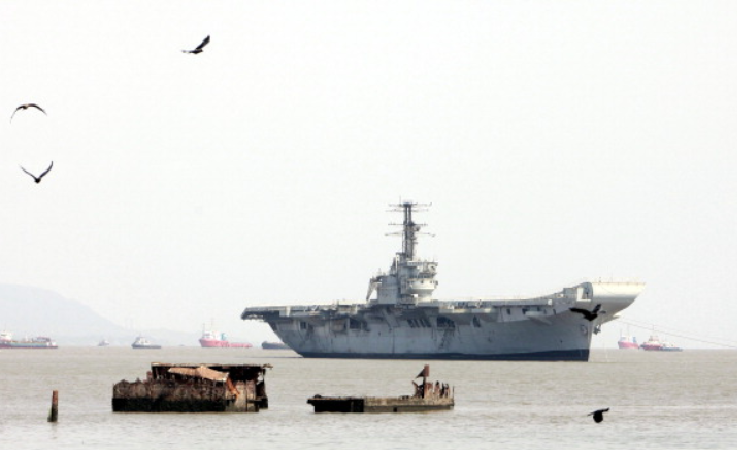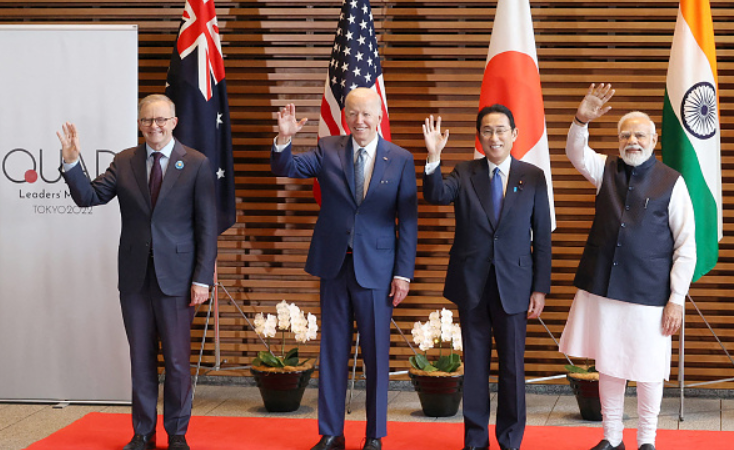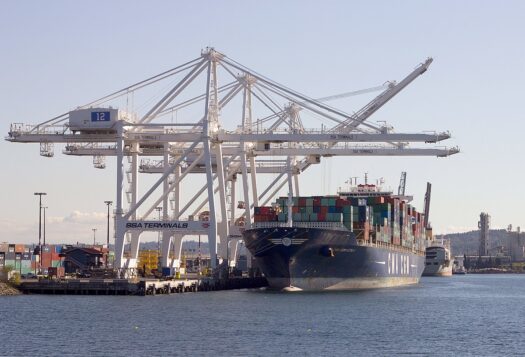
Competition in the Indo-Pacific threatens to disrupt regional stability. While the Quad aims to secure a free, open, and rule-based order, China views the group as an effort to contain its rise. Consequently, China seeks to advance its naval nuclear capabilities and expand its maritime reach to counterbalance Quad activities. While the Quad and the PRC bolster maritime capabilities and operations, a greater understanding of maritime nuclear security in the Indo-Pacific is needed to ensure regional stability.
The People’s Liberation Army Navy (PLAN) is securing new naval infrastructure worldwide, including in Cambodia, Tanzania, Kiribati, the Solomon Islands, Myanmar, Sri Lanka, Pakistan, and the United Arab Emirates. In addition, Beijing has acquired low-yield nuclear weapons, shown reluctance in sharing nuclear material-related data with the Comprehensive Nuclear-Test-Ban Treaty Organization (CTBTO), inducted new nuclear-powered ballistic-missile submarines, and undertaken bathymetric and ocean mapping surveys for sub-surface military operations in the Indian Ocean Region (IOR). Analysts suggest that each of these activities poses severe strategic threats to established maritime security and sovereignty norms and freedom of navigation.
Notwithstanding, China justifies its posturing by noting certain acts of Quad members, including the formation of AUKUS, the expansion of the Malabar naval exercise, and increasing maritime security cooperation between the United States and India in critical technologies. The Quad’s response to China via nuclear build-ups without a robust maritime nuclear security strategy (MNSS) also threatens the longevity of the Indo-Pacific construct.
While the Quad and the PRC bolster maritime capabilities and operations, a greater understanding of maritime nuclear security in the Indo-Pacific is needed to ensure regional stability.
China continues to pursue naval dominance and intensify its nuclear arms buildup amid nuclear terrorism and the development of emerging sub-critical nuclear technologies. By formulating a consensus among the Quad countries on maritime nuclear security in the Indo-Pacific, the grouping can not only earn the trust of non-nuclear weapon states but can also dispel potential nuclear arms races in the region while advocating for renewed maritime nuclear security norms and regulations to counter China.
China’s Growing Naval Capabilities
PLAN is the world’s fastest-growing navy, indicating China’s commitment to strengthening its naval resolve over other states in the region. Six of the PLAN’s more than 66 submarines are nuclear-powered and designed to launch ballistic missiles with nuclear payloads.
To gain an advantage in the Indo-Pacific, China has pursued a three-pronged strategy— constructing dual-use infrastructure projects through the Belt and Road Initiative (BRI) for military outreach; expanding nuclear naval capabilities to elevate its power status; and acquiring an alternative access route to the Indian Ocean through Pakistan. To operationalize this strategy, China is bolstering anti-submarine warfare to prevent hostile chokepoints. Similarly, Beijing is diversifying its deterrence credibility, retaliatory abilities, and strategic superiorities to match regional competitors like Japan and India. China is also providing comprehensive assistance to rejuvenate the Pakistani Navy through technology transfers, financial support, training and capacity building, and the sale of nuclear attack submarines, including possible plans to deploy nuclear submarines at Gwadar Port in Pakistan.
China’s naval support for Pakistan has encouraged India to follow suit. India has launched and intensified its indigenous ballistic missile from the INS Arihant and INS Vikrant. India is also engaging in multilateral maritime maneuvering to signal against Chinese naval build-up. For example, India invited Japan to co-develop and operationalize nuclear submarines in the South China Sea. Moreover, India seeks to acquire nuclear submarine building support from France. India’s response to the Chinese naval strategy aggravates regional instability and increases the risk of a naval nuclear arms race.
Preventing a Naval Nuclear Arms Race
The Quad should prevent a naval nuclear arms race by initiating discussions with China and Pakistan. A dialogue can help to understand each other’s threat perceptions and consequently lead to joint consultative mechanisms for maritime nuclear security. The dialogue process would also forge certain nuclear arms reduction and confidence-building measures. Joining such a dialogue would also serve China’s interests by illustrating its position on avoiding hegemonic motives in the Indo-Pacific and ensuring the Quad avoids further expansion in the region.
China is recalibrating its naval expansion in the Indo-Pacific due to the Quad’s evolving consolidation of its Indo-Pacific vision. The Quad is offering countries an alternative to China for infrastructure development in health, education, and emerging technologies, which could prove lucrative amid strong pushback to the BRI from countries like Myanmar, Pakistan, Malaysia, and Sri Lanka. The Quad’s rise will loosen China’s economic sway in the region and weaken its offensive political narrative against the Quad. Therefore, China would be inclined to join a multilateral dialogue to restrict the emergence of a global anti-China coalition. Though some Chinese strategic analysts suggest Beijing hold talks with Washington to moderate the potentiality of containment, the Quad must invite China to such dialogues to dissuade an arms race. So far, the Quad has yet to do so. However, the exclusion of China from discussions on nuclear security invites more risks, and including China at the discussion table in any capacity would be an improvement.
Inaction by the Quad to secure effective norms for maritime nuclear security would also taint its reputation as a peace-seeking multilateral grouping. In addition, failure to establish such a dialogue would further validate Chinese allegations of the Quad as “a destabilizing clique of nations”. Therefore, the Quad must demonstrate its willingness to rally support from resident non-nuclear weapon states, small-island countries, and those who have been actively practicing non-proliferation regimes.

India is keen to develop a maritime nuclear governance system through the Quad. Doing so would reduce naval tensions in the Indian Ocean Region, serve as an opportunity to discuss nuclear risk reduction measures with hostile neighbors, and limit competition for numerical and technological naval superiority. Similarly, initiating dialogue for naval nuclear security could de-escalate its border tensions with China. The Quad is best positioned to use its existing relationships with smaller states in the Indo-Pacific to pressure China to the discussion table while also exhibiting its good faith in reaching out to China to secure regional stability. Excluding China and Pakistan from a future maritime nuclear security architecture for the Indo-Pacific region is not strategically feasible.
Forging a New Maritime Nuclear Security Strategy
In addition to preventing a naval nuclear arms race, the Quad should forge a new maritime nuclear security strategy. Currently, there is no prospective maritime nuclear strategy or policy in any Quad joint documents or Washington’s Indo-Pacific Strategy. A new Quad agenda should include building inclusive and deliberative maritime nuclear security norms, rather than prioritizing military-nuclear security alliances. For this, the Quad must convene multiple states on a single platform to discuss emerging nuclear vulnerabilities along with an effective verification process for nuclear arms control and disarmament. The existing working mechanism for nuclear disarmament between Norway, Sweden, the UK, and the United States is an example of forging a new agenda for the Indo-Pacific. Also, the Quad can shore up support from Southeast Asian states. The ASEAN Foreign Ministers have underscored that nuclear weapon states should fulfill their obligations in accordance with the Non-Proliferation Treaty (NPT).
A sustainable dialogue would help in bringing doctrinal clarity, transparency in the possession of nuclear inventory, and the opening of a proper system of information sharing on the deployment of nuclear weapons.
Furthermore, the Quad should reassure members of the Treaty on the Prohibition of Nuclear Weapons (TPNW) and other Nuclear-Weapon-Free Zones (NWFZs) treaties, including Rarotonga, Bangkok, and Pelindaba that it will uphold these established maritime nuclear security norms by defusing nuclear tensions and showcasing its commitment for rule-based order.
A sustainable dialogue would help in bringing doctrinal clarity, transparency in the possession of nuclear inventory, and the opening of a proper system of information sharing on the deployment of nuclear weapons. All these would limit suspicion and other associated accidental risks. The logic of nuclear deterrence and contemporary political context suggest that China cannot afford to be out of such initiatives. Therefore, the Quad must urgently advocate for this agenda in its mid-2023 summit in Australia. Initiating this agenda is necessary to deter nuclear arms racing in the Indo-Pacific and shore up support from smaller regional states to pressure China to cease its offensive measures.
***
Image 1: Imtiyaz Shaikh/Anadolu Agency/Getty Images
Image 2: STR/AFP via Getty Images


